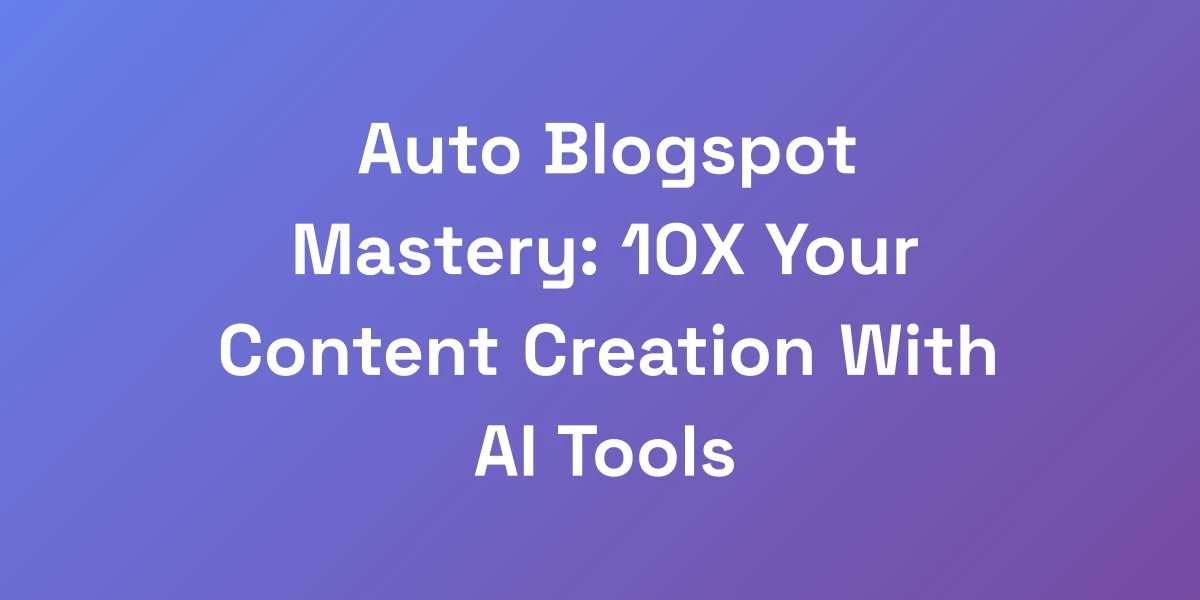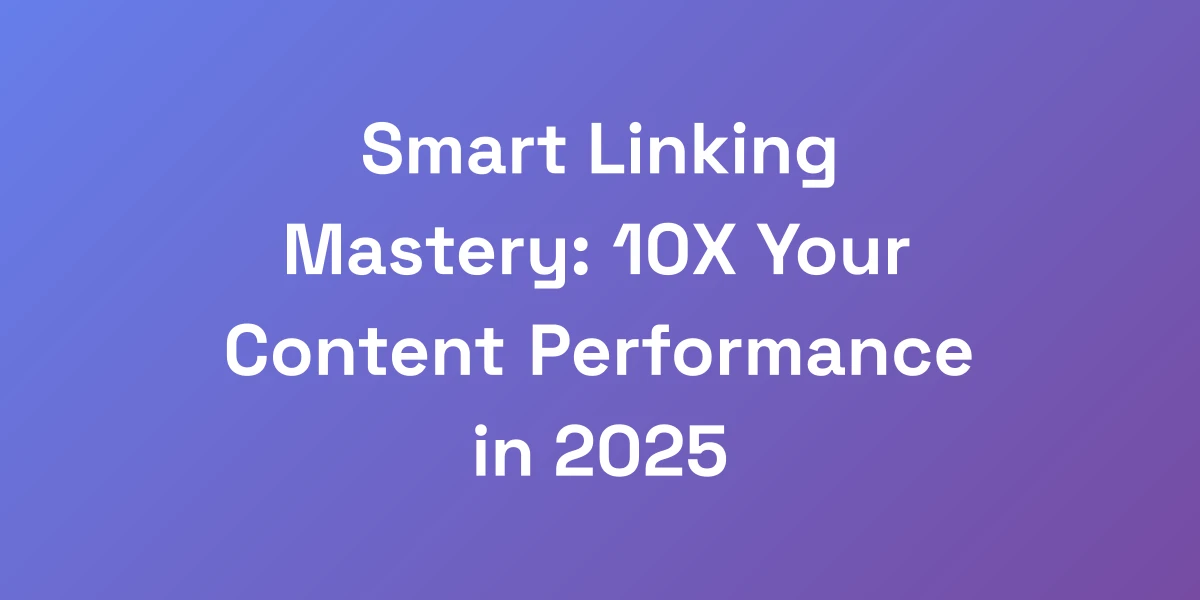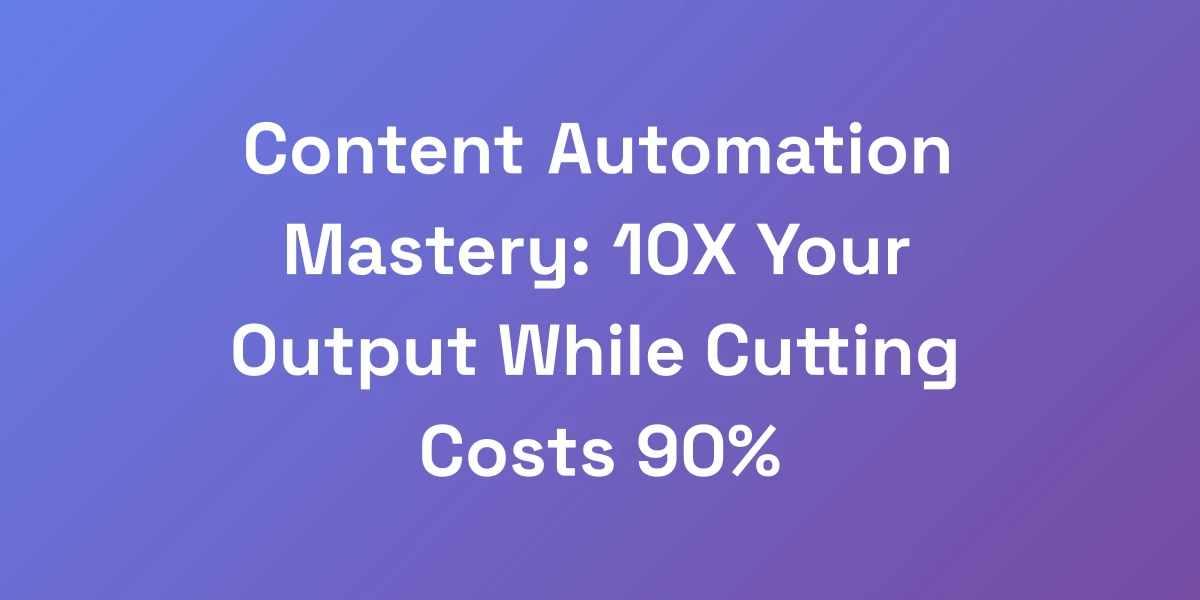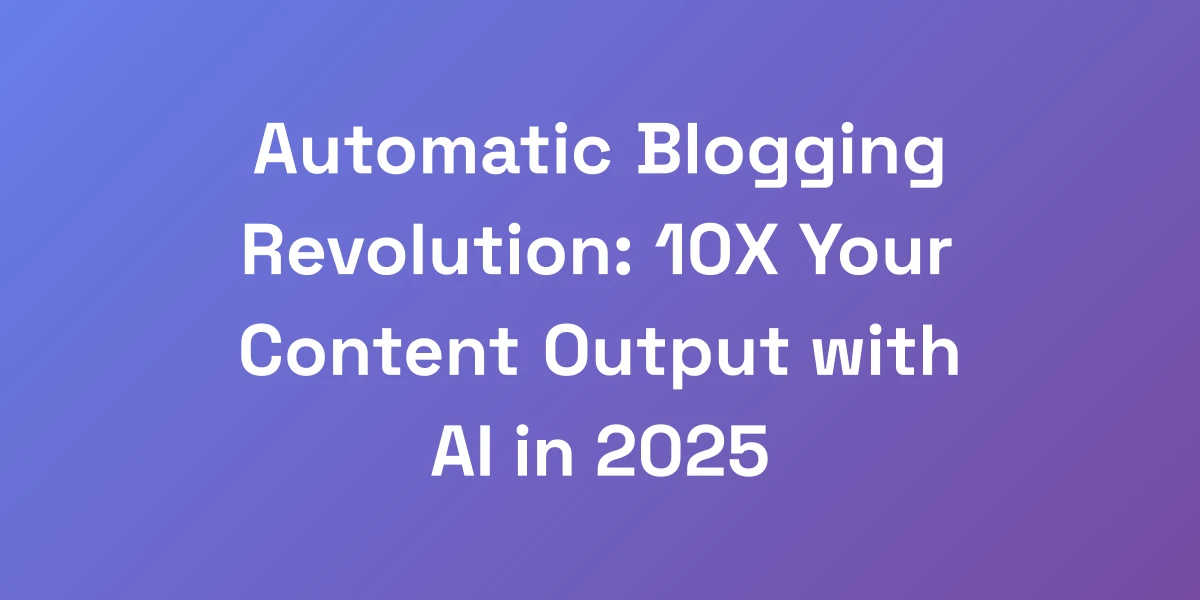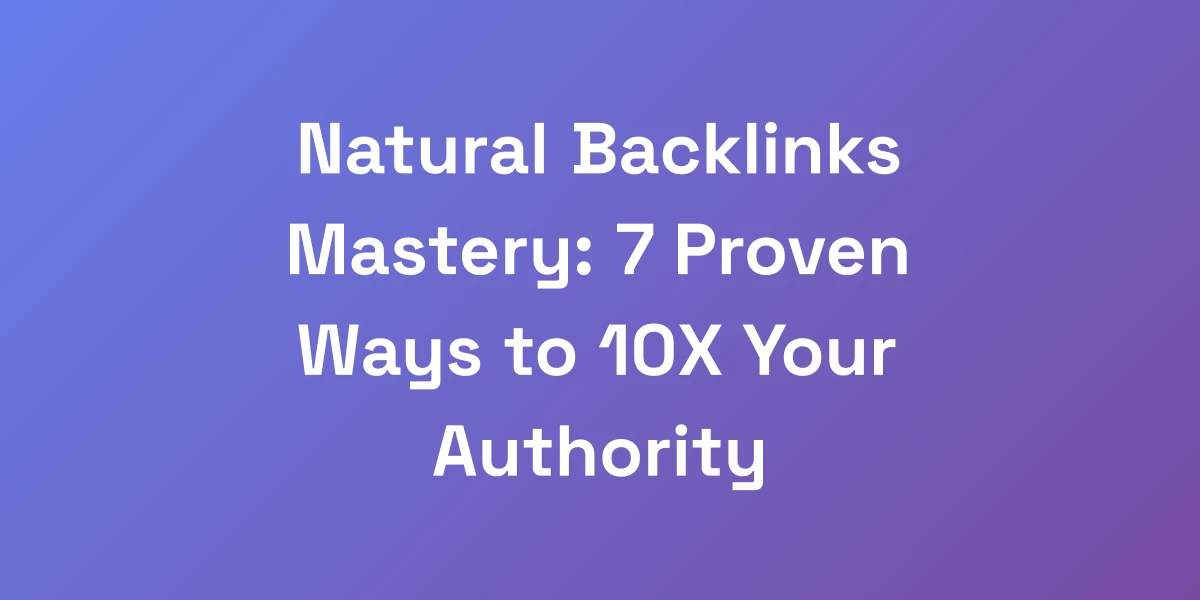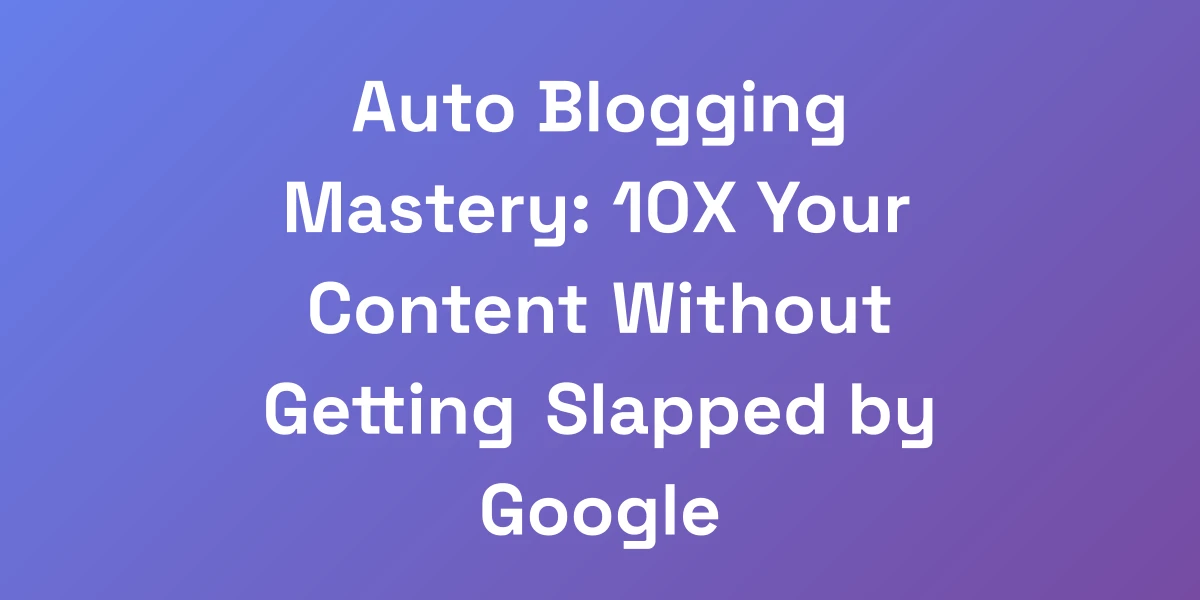
Auto Blogging Mastery: 10X Your Content Without Getting Slapped by Google
Mar 14, 2025 | By [email protected]
Introduction
We’re diving into a goldmine many overlook: auto blogging. Imagine 10x your content output without the fear of Google slamming you. Sounds impossible? It’s not. The game has changed, and those who understand the shifts are reaping massive rewards.
Auto blogging isn’t the wild west some make it out to be. It’s evolved, stripped of its dirty reputation when done right. We’ve spent over $50,000 experimenting, testing AI content tools, and refining strategies that most get wrong. The truth? 90% are screwed because they miss the mark. But we’ve cracked a proven framework that harnesses AI effectively, keeping Google happy while you scale effortlessly.
Ready to transform your content strategy? Let’s break down how to leverage AI for auto blogging, avoid common pitfalls, and achieve content mastery that propels your site to the top. Stick with us, and you’ll discover the secrets to staying in Google’s good graces while flooding your site with high-quality, engaging posts.
The Truth About Auto Blogging in 2025: Risk vs. Reward
Let me cut through the BS right now — auto blogging isn’t dead, but it’s evolved. We’ve personally tested dozens of AI content tools and spent over $50,000 experimenting with different approaches. Here’s what nobody’s telling you: 90% of people are doing it wrong and getting hammered by Google. But there’s a proven framework that lets you leverage AI for content creation while staying in Google’s good graces. We’re going to show you exactly how to 10x your content output without triggering any penalties or losing rankings.
The Current State of AI Content Generation
AI content generation has come a long way. Back in the day, AI-produced content was often flagged for being mechanical and lacking depth. Fast forward to 2025, and the landscape has shifted dramatically.
Now, AI can create content that’s not just coherent but also contextually rich and engaging. Tools like Autoblogging AI and Journalist AI have revolutionized how we approach content creation, offering features like quick mode for rapid content generation and intelligent interlinking for SEO benefits. Check out this Autoblogging AI review to see how it stands out.
- autoBlogger offers SEO-optimized content tailored for platforms like Shopify, automating posting and integrating backlinks seamlessly.
- Autoblogging Pro focuses on WordPress users, providing high-quality, AI-generated articles optimized for major SEO plugins.
These advancements mean that when wielded correctly, AI can be a powerful ally in expanding your content library without losing the personal touch that keeps readers engaged.
Why Most Auto Blogging Attempts Fail
Here’s the harsh truth: most auto blogging attempts crash and burn because they ignore the finer points of quality and SEO alignment.
Why does this happen?
- Lack of Originality: AI can sometimes regurgitate existing information without adding unique insights.
- Poor Integration: Failing to integrate AI tools into a cohesive workflow disrupts consistency.
- Neglecting E-E-A-T: Focusing solely on volume over Expertise, Experience, Authoritativeness, and Trustworthiness leads to content penalties.
Without addressing these core issues, auto blogging isn’t just ineffective—it’s a direct route to penalties and declining rankings.
Risk Assessment Framework
Before jumping into auto blogging, it’s crucial to assess the risks meticulously. Here’s how we do it:
- Content Quality Audit: Regularly evaluate the quality of AI-generated content against standards.
- SEO Compliance Check: Ensure all content aligns with the latest Google algorithm updates, focusing on user-centric value.
- Monitoring Tools: Utilize tools like Google Analytics and SEMrush to track content performance and detect any drops in rankings.
Implementing this framework helps us mitigate risks by staying ahead of potential issues, ensuring that our auto blogging strategy remains robust and effective.
Success Metrics and Benchmarks
Success in auto blogging isn’t just about quantity; it’s about measurable impact. Here are our key metrics:
- Organic Traffic Growth: Track the increase in visitors from search engines.
- Engagement Rates: Monitor metrics like average session duration and bounce rate.
- Conversion Rates: Measure how effectively content drives desired actions, such as sign-ups or sales.
- SEO Performance: Assess improvements in keyword rankings and backlink profiles.
These benchmarks provide a clear picture of how well your auto blogging efforts are performing, allowing you to make data-driven adjustments for continuous improvement. For more insights, refer to the 2024 content marketing benchmarks.
The New Rules of AI Content
AI content creation has its own set of rules that differ significantly from traditional content strategies. To stay compliant and effective, adhere to these new guidelines:
- User-Centric Content: Prioritize content that adds real value to users, focusing on originality and helpfulness.
- Enhanced E-E-A-T: Demonstrate Expertise, Experience, Authoritativeness, and Trustworthiness through every piece of content.
- Technical Precision: Ensure all technical SEO elements, such as meta tags, structured data, and mobile optimization, are impeccably implemented.
- Continuous Optimization: Regularly update and refine content based on performance data and evolving SEO guidelines.
Following these rules ensures your AI-generated content not only survives but thrives in Google’s ever-evolving ecosystem.
Building Your Auto Blogging Infrastructure
Listen, your tech stack will make or break your auto blogging success. After building multiple 7-figure content businesses, we’ve learned that it’s not about using the most expensive tools—it’s about creating the right operational system. You need three core components: content generation, quality control, and distribution. But here’s the kicker—it’s how you integrate these components that determines whether you’ll crush it or crash and burn.
Essential Tool Stack Components
A robust tool stack is the backbone of any successful auto blogging operation. Here’s what you need:
- AI Content Generators: Tools like Autoblogging AI and Journalist AI are essential for creating bulk content efficiently.
- SEO Optimization Tools: Platforms like SEMrush or Ahrefs help ensure your content is SEO-friendly and aligns with current best practices.
- Content Management Systems: WordPress remains a top choice for its flexibility and extensive plugin ecosystem, crucial for automation and scalability.
- Analytics Platforms: Google Analytics and Google Search Console are non-negotiable for tracking performance and making data-driven decisions.
Each component plays a crucial role in creating a seamless workflow that supports high-quality content production and distribution.
Content Generation Workflow Design
Designing an efficient workflow for content generation is pivotal. Here’s our step-by-step process:
- Topic Research: Identify trending topics and keywords using tools like SEMrush.
- Content Creation: Use AI tools to draft articles, ensuring each piece aligns with the identified topics and keywords.
- SEO Optimization: Optimize content with relevant meta tags, headers, and internal links.
- Quality Control: Implement checks to ensure the content meets quality standards before publishing.
By following this structured workflow, you ensure consistency and efficiency in your content creation process, maximizing output without compromising quality.
Quality Control Checkpoints
Quality control is non-negotiable in auto blogging. Here’s how we maintain high standards:
- Initial AI Draft Review: Each AI-generated article undergoes a thorough review for relevance, coherence, and accuracy.
- SEO Compliance: Ensure all SEO elements are correctly implemented, including keyword placement and meta descriptions.
- Human Editing: Incorporate human insights to refine the content, adding unique perspectives and ensuring it resonates with the audience. Learn more about using AI for content quality assurance.
These checkpoints help us catch any issues early, maintaining the integrity and quality of our content.
Human Oversight Integration
While AI handles the heavy lifting, human oversight ensures the content remains authentic and valuable. Here’s our integration strategy:
- Editorial Review: Assign editors to review and refine AI-generated content, adding personal touches and ensuring brand consistency.
- Expert Contributions: Incorporate insights from industry experts to enhance credibility and authority.
- User Feedback Loops: Use feedback from readers to continuously improve and adapt content strategies.
By blending human expertise with AI efficiency, we create content that’s both scalable and deeply engaging.
Scaling Systems and Processes
Once your infrastructure is in place, scaling is the next step. Here’s how we do it:
- Automate Repetitive Tasks: Use automation tools to handle routine tasks like scheduling posts and updating content.
- Expand Content Categories: Diversify your content topics to reach a broader audience without overextending your resources.
- Invest in Team Training: Continuously train your team to leverage new tools and techniques, ensuring everyone is up to date with the latest best practices.
Scaling isn’t just about producing more—it’s about doing so efficiently while maintaining the quality that keeps your audience engaged.
The Human-AI Hybrid Content Model
Here’s the million-dollar secret: pure AI content is dead. But a hybrid approach? That’s printing money. We’ve developed a system that combines AI efficiency with human expertise, resulting in content that not only ranks but converts like crazy. The key is understanding where AI excels and where human touch creates irreplaceable value. This isn’t about replacing writers—it’s about supercharging their capabilities.
Defining AI vs. Human Roles
To maximize the benefits of AI, clearly define the roles of AI and human contributors:
- AI Responsibilities: Drafting content, conducting initial research, and generating SEO-optimized text.
- Human Responsibilities: Editing for voice and tone, adding unique insights, and ensuring factual accuracy.
This delineation ensures each component plays to its strengths, resulting in a polished, high-quality final product.
Content Enhancement Strategies
Enhancing content goes beyond basic revisions. Here are our strategies:
- Layered Editing: Multiple rounds of edits focusing on different aspects—factual accuracy, SEO optimization, and readability.
- Incorporate Multimedia: Add images, videos, and infographics to enrich content and boost engagement.
- Storytelling Elements: Integrate narratives and real-life examples to make content more relatable and compelling.
These strategies ensure content isn’t just informative but also engaging and memorable.
Voice and Brand Consistency
Maintaining a consistent voice across all content pieces is crucial:
- Style Guides: Develop comprehensive style guides that outline tone, language, and formatting rules.
- Regular Audits: Conduct periodic reviews to ensure all content adheres to brand standards.
- Training Sessions: Continuously train your team on maintaining voice consistency, especially when integrating new tools or team members.
Consistency reinforces your brand identity, building trust and recognition with your audience.
Editorial Guidelines
Establishing clear editorial guidelines ensures every piece of content meets your standards:
- Content Objectives: Define the purpose and goals for each content piece, aligning with overall strategy.
- Formatting Rules: Standardize headers, bullet points, and other formatting elements for uniformity.
- Quality Benchmarks: Set minimum standards for grammar, readability, and factual accuracy.
These guidelines act as a roadmap, ensuring each content piece is crafted with precision and purpose.
Training AI for Better Output
The effectiveness of AI-generated content hinges on how well you train your tools:
- Customized Prompts: Develop specific prompts that guide AI to produce relevant and high-quality content.
- Feedback Loops: Continuously provide feedback to refine AI outputs, enhancing accuracy and relevance.
- Data Feeding: Supply AI with comprehensive data sets related to your niche, improving its contextual understanding.
By investing in AI training, you ensure the content produced is aligned with your standards and objectives.
SEO-Proof Your Auto Blogging Strategy
Most people get destroyed by Google because they ignore the fundamental signals that separate high-quality content from AI-generated fluff. Through extensive testing, we’ve identified the exact markers Google looks for when evaluating content quality. By implementing these specific strategies, we’ve maintained top rankings across multiple niches while using AI to scale our content production by 10x.
Google’s Content Quality Signals
Google’s algorithms are designed to prioritize content that delivers real value to users. Here’s what to focus on:
- Relevance: Ensure your content directly addresses the search intent behind keywords.
- Comprehensiveness: Cover topics in-depth, providing all necessary information the user seeks.
- Engagement: Craft content that keeps readers engaged, reducing bounce rates and increasing dwell time.
By aligning your content with these signals, you enhance its chances of ranking well and attracting organic traffic.
E-E-A-T Implementation
E-E-A-T stands for Experience, Expertise, Authoritativeness, and Trustworthiness. Here’s how to implement it:
- Experience: Showcase real-world experience, either through case studies or firsthand accounts.
- Expertise: Demonstrate deep knowledge in your niche, backed by credible sources and data.
- Authoritativeness: Build authority by obtaining backlinks from reputable sites and being recognized as a thought leader.
- Trustworthiness: Ensure your content is accurate, transparent, and meets ethical standards.
Incorporating E-E-A-T principles not only boosts SEO but also builds trust with your audience, making your content more impactful.
Technical SEO Considerations
Technical SEO is the foundation that supports your content’s visibility. Key considerations include:
- Site Speed: Optimize loading times to prevent high bounce rates.
- Mobile Optimization: Ensure your site is fully responsive and operates smoothly on all devices.
- Structured Data: Use schema markup to help search engines understand and index your content effectively.
- Secure Connections: Implement HTTPS to secure data and enhance user trust.
Proper technical SEO ensures that your content is not only discovered but also favored by search engines in their rankings.
Content Differentiation Tactics
Standing out in a saturated market requires unique approaches:
- Unique Perspectives: Offer fresh angles or insights that aren’t commonly found in existing content.
- Multimedia Integration: Enhance content with videos, infographics, and interactive elements to increase engagement.
- Personalization: Tailor content to specific audience segments, addressing their unique needs and preferences.
Differentiating your content not only attracts attention but also keeps your audience coming back for more.
Monitoring and Adjustment Protocols
Continuous monitoring and adjustments are key to maintaining SEO performance:
- Performance Tracking: Use analytics tools to monitor key metrics and identify areas for improvement.
- Regular Reporting: Generate reports to analyze performance trends and make informed decisions.
- Data-Driven Adjustments: Use performance data to tweak content strategies, focusing on areas that yield the best results.
By keeping a close eye on performance, you can make timely adjustments to optimize your content strategy and ensure continued growth.
Building Your Auto Blogging Infrastructure
Listen, your tech stack will make or break your auto blogging success. After building multiple 7-figure content businesses, we’ve learned that it’s not about using the most expensive tools—it’s about creating the right operational system. You need three core components: content generation, quality control, and distribution. But here’s the kicker—it’s how you integrate these components that determines whether you’ll crush it or crash and burn.
Essential Tool Stack Components
A robust tool stack is the backbone of any successful auto blogging operation. Here’s what you need:
- AI Content Generators: Tools like Autoblogging AI and Journalist AI are essential for creating bulk content efficiently.
- SEO Optimization Tools: Platforms like SEMrush or Ahrefs help ensure your content is SEO-friendly and aligns with current best practices.
- Content Management Systems: WordPress remains a top choice for its flexibility and extensive plugin ecosystem, crucial for automation and scalability.
- Analytics Platforms: Google Analytics and Google Search Console are non-negotiable for tracking performance and making data-driven decisions.
Each component plays a crucial role in creating a seamless workflow that supports high-quality content production and distribution.
Content Generation Workflow Design
Designing an efficient workflow for content generation is pivotal. Here’s our step-by-step process:
- Topic Research: Identify trending topics and keywords using tools like SEMrush.
- Content Creation: Use AI tools to draft articles, ensuring each piece aligns with the identified topics and keywords.
- SEO Optimization: Optimize content with relevant meta tags, headers, and internal links.
- Quality Control: Implement checks to ensure the content meets quality standards before publishing.
By following this structured workflow, you ensure consistency and efficiency in your content creation process, maximizing output without compromising quality.
Quality Control Checkpoints
Quality control is non-negotiable in auto blogging. Here’s how we maintain high standards:
- Initial AI Draft Review: Each AI-generated article undergoes a thorough review for relevance, coherence, and accuracy.
- SEO Compliance: Ensure all SEO elements are correctly implemented, including keyword placement and meta descriptions.
- Human Editing: Incorporate human insights to refine the content, adding unique perspectives and ensuring it resonates with the audience. Learn more about using AI for content quality assurance.
These checkpoints help us catch any issues early, maintaining the integrity and quality of our content.
Human Oversight Integration
While AI handles the heavy lifting, human oversight ensures the content remains authentic and valuable. Here’s our integration strategy:
- Editorial Review: Assign editors to review and refine AI-generated content, adding personal touches and ensuring brand consistency.
- Expert Contributions: Incorporate insights from industry experts to enhance credibility and authority.
- User Feedback Loops: Use feedback from readers to continuously improve and adapt content strategies.
By blending human expertise with AI efficiency, we create content that’s both scalable and deeply engaging.
Scaling Systems and Processes
Once your infrastructure is in place, scaling is the next step. Here’s how we do it:
- Automate Repetitive Tasks: Use automation tools to handle routine tasks like scheduling posts and updating content.
- Expand Content Categories: Diversify your content topics to reach a broader audience without overextending your resources.
- Invest in Team Training: Continuously train your team to leverage new tools and techniques, ensuring everyone is up to date with the latest best practices.
Scaling isn’t just about producing more—it’s about doing so efficiently while maintaining the quality that keeps your audience engaged.
The Human-AI Hybrid Content Model
Here’s the million-dollar secret: pure AI content is dead. But a hybrid approach? That’s printing money. We’ve developed a system that combines AI efficiency with human expertise, resulting in content that not only ranks but converts like crazy. The key is understanding where AI excels and where human touch creates irreplaceable value. This isn’t about replacing writers—it’s about supercharging their capabilities.
Defining AI vs. Human Roles
To maximize the benefits of AI, clearly define the roles of AI and human contributors:
- AI Responsibilities: Drafting content, conducting initial research, and generating SEO-optimized text.
- Human Responsibilities: Editing for voice and tone, adding unique insights, and ensuring factual accuracy.
This delineation ensures each component plays to its strengths, resulting in a polished, high-quality final product.
Content Enhancement Strategies
Enhancing content goes beyond basic revisions. Here are our strategies:
- Layered Editing: Multiple rounds of edits focusing on different aspects—factual accuracy, SEO optimization, and readability.
- Incorporate Multimedia: Add images, videos, and infographics to enrich content and boost engagement.
- Storytelling Elements: Integrate narratives and real-life examples to make content more relatable and compelling.
These strategies ensure content isn’t just informative but also engaging and memorable.
Voice and Brand Consistency
Maintaining a consistent voice across all content pieces is crucial:
- Style Guides: Develop comprehensive style guides that outline tone, language, and formatting rules.
- Regular Audits: Conduct periodic reviews to ensure all content adheres to brand standards.
- Training Sessions: Continuously train your team on maintaining voice consistency, especially when integrating new tools or team members.
Consistency reinforces your brand identity, building trust and recognition with your audience.
Editorial Guidelines
Establishing clear editorial guidelines ensures every piece of content meets your standards:
- Content Objectives: Define the purpose and goals for each content piece, aligning with overall strategy.
- Formatting Rules: Standardize headers, bullet points, and other formatting elements for uniformity.
- Quality Benchmarks: Set minimum standards for grammar, readability, and factual accuracy.
These guidelines act as a roadmap, ensuring each content piece is crafted with precision and purpose.
Training AI for Better Output
The effectiveness of AI-generated content hinges on how well you train your tools:
- Customized Prompts: Develop specific prompts that guide AI to produce relevant and high-quality content.
- Feedback Loops: Continuously provide feedback to refine AI outputs, enhancing accuracy and relevance.
- Data Feeding: Supply AI with comprehensive data sets related to your niche, improving its contextual understanding.
By investing in AI training, you ensure the content produced is aligned with your standards and objectives.
SEO-Proof Your Auto Blogging Strategy
Most people get destroyed by Google because they ignore the fundamental signals that separate high-quality content from AI-generated fluff. Through extensive testing, we’ve identified the exact markers Google looks for when evaluating content quality. By implementing these specific strategies, we’ve maintained top rankings across multiple niches while using AI to scale our content production by 10x.
Google’s Content Quality Signals
Google’s algorithms are designed to prioritize content that delivers real value to users. Here’s what to focus on:
- Relevance: Ensure your content directly addresses the search intent behind keywords.
- Comprehensiveness: Cover topics in-depth, providing all necessary information the user seeks.
- Engagement: Craft content that keeps readers engaged, reducing bounce rates and increasing dwell time.
By aligning your content with these signals, you enhance its chances of ranking well and attracting organic traffic.
E-E-A-T Implementation
E-E-A-T stands for Experience, Expertise, Authoritativeness, and Trustworthiness. Here’s how to implement it:
- Experience: Showcase real-world experience, either through case studies or firsthand accounts.
- Expertise: Demonstrate deep knowledge in your niche, backed by credible sources and data.
- Authoritativeness: Build authority by obtaining backlinks from reputable sites and being recognized as a thought leader.
- Trustworthiness: Ensure your content is accurate, transparent, and meets ethical standards.
Incorporating E-E-A-T principles not only boosts SEO but also builds trust with your audience, making your content more impactful.
Technical SEO Considerations
Technical SEO is the foundation that supports your content’s visibility. Key considerations include:
- Site Speed: Optimize loading times to prevent high bounce rates.
- Mobile Optimization: Ensure your site is fully responsive and operates smoothly on all devices.
- Structured Data: Use schema markup to help search engines understand and index your content effectively.
- Secure Connections: Implement HTTPS to secure data and enhance user trust.
Proper technical SEO ensures that your content is not only discovered but also favored by search engines in their rankings.
Content Differentiation Tactics
Standing out in a saturated market requires unique approaches:
- Unique Perspectives: Offer fresh angles or insights that aren’t commonly found in existing content.
- Multimedia Integration: Enhance content with videos, infographics, and interactive elements to increase engagement.
- Personalization: Tailor content to specific audience segments, addressing their unique needs and preferences.
Differentiating your content not only attracts attention but also keeps your audience coming back for more.
Monitoring and Adjustment Protocols
Continuous monitoring and adjustments are key to maintaining SEO performance:
- Performance Tracking: Use analytics tools to monitor key metrics and identify areas for improvement.
- Regular Reporting: Generate reports to analyze performance trends and make informed decisions.
- Data-Driven Adjustments: Use performance data to tweak content strategies, focusing on areas that yield the best results.
By keeping a close eye on performance, you can make timely adjustments to optimize your content strategy and ensure continued growth.
Scaling Your Auto Blogging Operation
Once you have the foundation right, it’s time to pour gasoline on the fire. But scaling isn’t just about producing more content—it’s about maintaining quality while increasing output. We’ll show you how we scaled from 10 articles per month to 300+ without sacrificing quality or triggering Google penalties. The secret lies in systematic optimization and knowing exactly when to accelerate vs. optimize.
Content Calendar Optimization
An optimized content calendar is crucial for efficient scaling:
- Strategic Planning: Plan content around key dates, trends, and seasonal topics to maximize relevance and engagement.
- Consistent Scheduling: Maintain a regular posting schedule to keep your audience engaged and signal reliability to search engines.
- Content Diversification: Balance different types of content—blogs, videos, infographics—to cater to varied audience preferences.
A well-structured calendar ensures that content production is organized and aligned with your strategic goals, facilitating smooth scaling.
Team Structure and Roles
A scalable team structure is essential for managing increased content volume:
- Content Strategists: Develop overarching content strategies and ensure alignment with business goals.
- Writers and Editors: Create and refine content, maintaining quality and consistency across all pieces.
- SEO Specialists: Optimize content for search engines, ensuring technical and on-page SEO standards are met.
- Project Managers: Oversee workflows, coordinate between teams, and ensure deadlines are met.
Having clearly defined roles allows for efficient workflow management and ensures that scaling efforts don’t compromise content quality.
Quality Assurance at Scale
Maintaining quality as you scale requires systematic approaches:
- Automated Checks: Use tools to automatically check for grammar, SEO compliance, and readability.
- Peer Reviews: Implement a peer review system where team members critique and improve each other’s work.
- Feedback Systems: Collect and incorporate feedback from your audience to continuously refine content quality. For additional insights, refer to the Media Quality Report.
These measures help ensure that increased content volume does not dilute the quality, keeping your audience engaged and maintaining SEO integrity.
Performance Tracking
Monitoring performance is vital to understand what’s working and what’s not:
- Key Metrics: Track metrics such as organic traffic, engagement rates, and conversion rates to gauge content effectiveness.
- Regular Reporting: Generate reports to analyze performance trends and make informed decisions.
- Data-Driven Adjustments: Use performance data to tweak content strategies, focusing on areas that yield the best results.
By keeping a close eye on performance, you can make timely adjustments to optimize your content strategy and ensure continued growth.
Cost Management Strategies
Scaling content operations can become costly, but effective cost management keeps it sustainable:
- Budget Allocation: Allocate budgets based on content performance, investing more in high-performing areas.
- Tool Optimization: Utilize cost-effective tools that offer the best ROI, avoiding overspending on unnecessary features.
- Outsourcing: Consider outsourcing certain tasks to freelancers or agencies to manage costs while maintaining quality.
- Efficiency Maximization: Streamline workflows to reduce redundant steps and improve overall efficiency.
Smart cost management ensures that scaling efforts are financially sustainable, allowing for continued growth without unnecessary expenses.
Conclusion
We’ve walked you through the intricate dance of auto blogging, balancing AI efficiency with human ingenuity to create a content powerhouse. The key takeaways? Embrace the hybrid model, focus relentlessly on quality, and stay attuned to Google’s ever-evolving standards. Our proven framework isn’t just about increasing content volume—it’s about doing it smartly, ensuring every piece adds value and drives engagement.
Ready to transform your content strategy? Start implementing these strategies today and watch your content output soar without the fear of Google penalties. We challenge you to take action—experiment with AI tools, refine your processes, and measure your success meticulously.
Have questions or experiences to share? Drop a comment below and let’s discuss how you’re mastering the art of auto blogging. Let’s grow together and dominate the content game!
